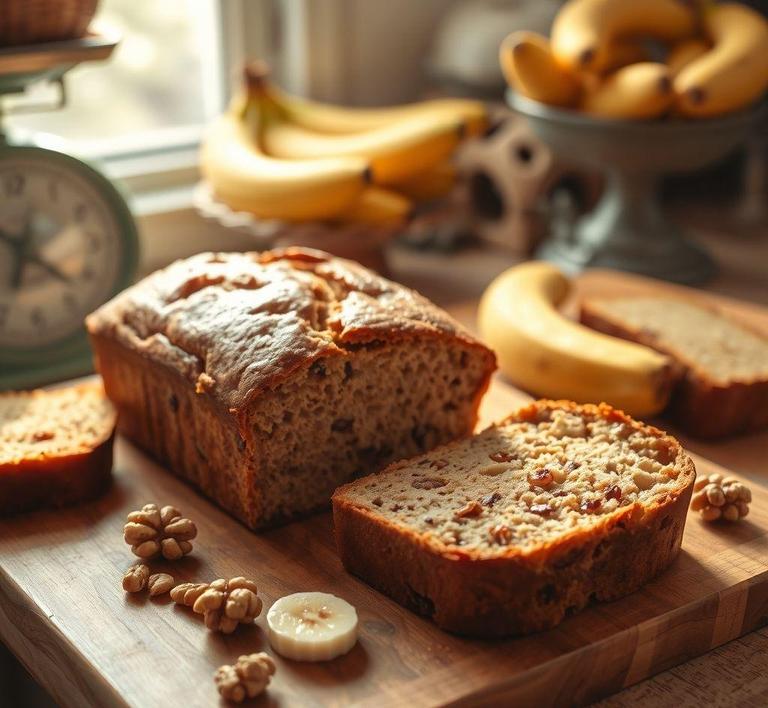Ever found yourself with a loaf of banana bread that’s too delicious to waste but you can’t finish it all at once? Refreezing banana bread is a great way to keep it fresh for later, without sacrificing that moist, sweet flavor. Whether you’ve made a big batch or have leftovers, knowing how to properly refreeze banana bread ensures that every slice stays just as tasty the next time you want to indulge. In this guide, we’ll walk you through the simple steps to properly freeze, defrost, and refreeze banana bread, so you can enjoy a slice whenever you want without worrying about it going stale.
Can You Refreeze Banana Bread?

When it comes to storing baked goods like banana bread, the question of whether or not you can refreeze it often arises. The simple answer is yes, banana bread can be refrozen, but with a few caveats and considerations to keep in mind.
Banana bread, being a moist and dense baked good, does indeed freeze well in the first place. It’s a common practice for home bakers to prepare large batches and freeze portions for future enjoyment. But the process of refreezing can get a bit tricky, especially when it comes to the texture and quality of the bread after multiple freeze-thaw cycles.
Freezing banana bread initially locks in its moisture and flavor, which is great for preservation. However, refreezing introduces new variables, such as a loss of moisture, changes in texture, and potential alterations in flavor. This happens because the water content in the bread forms ice crystals, and each thawing process causes the structure of the bread to break down slightly. When you freeze it again, the moisture may not redistribute evenly, resulting in a less than optimal texture upon the second thaw.
How To Refreeze Banana Bread?
If you decide to go ahead and refreeze your banana bread, it’s important to follow the proper steps to minimize any loss in quality. Here’s how to refreeze banana bread effectively:
- Let the Banana Bread Cool Completely: Before freezing banana bread (whether for the first or second time), ensure it’s completely cooled. This helps avoid condensation inside the wrapping or container, which can cause sogginess or freezer burn.
- Slice Before Freezing: If you’ve already thawed a loaf of banana bread, slice it before you refreeze. This makes it easier to defrost smaller portions, preventing the need to thaw the entire loaf each time. Slices will also freeze more quickly and evenly than a whole loaf.
- Wrap Properly: Wrap the banana bread in plastic wrap or wax paper, followed by a layer of aluminum foil or place it in an airtight freezer-safe container or resealable plastic bag. This dual-layering method ensures it’s well-protected from freezer burn and helps retain its moisture.
- Label the Freezer Bag or Container: It’s easy to forget when you froze something, especially when it’s already been thawed once. Label your banana bread with the date and contents so you can track how long it’s been in the freezer.
- Freeze Quickly: Place the wrapped banana bread in the coldest part of the freezer. Quick freezing helps preserve the texture better, so avoid overcrowding or leaving the bread in a space where it may thaw slightly before freezing solid.
- Thawing: When you’re ready to eat your refrozen banana bread, thaw it at room temperature. This prevents it from becoming soggy, as thawing in a microwave or oven can introduce additional moisture.
By taking these precautions, you can help maintain the bread’s quality and minimize the negative effects of refreezing.
Quality Impact
While refreezing banana bread is feasible, there is an inevitable impact on its overall quality. Here are the main aspects that could be affected:
1. Texture
Banana bread is inherently moist and dense, and that moisture is key to its delicious texture. However, freezing and refreezing disrupts the structure of the bread. The ice crystals that form during freezing break down the bread’s cellular structure, causing it to lose some of its softness and become drier. If refrozen repeatedly, the bread may also lose its fluffiness and become somewhat crumbly.
2. Moisture Loss
Each cycle of freezing and thawing can contribute to moisture loss. Banana bread that’s been frozen multiple times may start to seem drier than a fresh loaf. This is especially true if it wasn’t wrapped securely, or if it was stored in the freezer for too long. The bread might become stale faster, and the once-rich banana flavor could diminish after multiple freezing cycles.
3. Flavor Alteration
Banana bread generally has a deep, sweet flavor, thanks to the bananas and the other ingredients. Freezing doesn’t tend to impact the flavor right away, but after refreezing, subtle changes may occur. The bread might lose some of its aromatic richness, and the banana taste can become more muted. The high sugar content in banana bread could crystallize during freezing, and this crystallization may alter its sweetness, though it’s not usually a significant change.
4. Appearance
Visually, refrozen banana bread could experience some changes. You may notice slight color shifts, where the surface of the bread may appear slightly more dehydrated, particularly around the edges. This can be more apparent if the bread was not well-wrapped before freezing. If freezer burn sets in, the bread may even develop visible, dry patches, which can also alter the texture.
5. Freezer Burn
If you’re refreezing banana bread, it’s important to ensure that it’s properly wrapped. If the wrapping isn’t airtight, freezer burn can develop. This will cause dry patches and can give the bread a leathery texture and undesirable flavor. A good wrapping method can prevent this, but it’s worth considering that the more often you freeze and thaw, the more chances there are for freezer burn to set in.
So, can you refreeze banana bread? Yes, but it comes with some trade-offs. While the act of refreezing won’t make your banana bread inedible, the texture, moisture, and flavor will likely be affected after multiple freeze-thaw cycles. If you’re in a pinch and need to refreeze your banana bread for convenience, follow the right steps to minimize quality loss.
The key takeaway is that refreezing banana bread should be a last resort if you want to preserve the best possible quality. If you plan on keeping it for an extended period, consider freezing individual slices rather than a whole loaf, which will give you better control over portion sizes and help reduce the need for frequent refreezing.
Ultimately, for the best experience, it’s always ideal to enjoy banana bread soon after it’s made or after its first freeze-thaw cycle. If you do find yourself in a situation where you need to refreeze it, just be mindful of the potential impact on quality and manage your expectations accordingly.
Is It Safe To Refreeze Banana Bread?
Banana bread is a beloved baked treat that often yields more than can be consumed in one sitting. Whether you’re dealing with leftovers or need to preserve it for later enjoyment, the question of whether it’s safe to refreeze banana bread might come up. The short answer is: yes, you can refreeze banana bread, but with some caveats.
Refreezing banana bread is generally safe as long as it has been thawed and handled correctly. The process of freezing and thawing doesn’t inherently ruin the bread, but the quality and texture can be affected with each cycle. When freezing banana bread, it’s crucial to ensure it is stored properly to maintain both flavor and moisture. Once thawed, banana bread can be refrozen, but you should pay close attention to the condition of the bread before doing so. Factors like the bread’s original texture, how long it’s been thawed, and whether it has been kept at a safe temperature all contribute to the safety and success of refreezing.
However, there is a limit to how many times banana bread can be frozen and refrozen before it loses its appeal. Each freezing and thawing cycle introduces the risk of moisture loss, which can result in a drier, denser loaf. This makes the bread less palatable, as it loses the soft, moist qualities that make banana bread so comforting in the first place.
Signs That Banana Bread Should Not Be Refrozen
Before deciding to refreeze banana bread, it’s important to look for specific signs that indicate it’s not a good idea. Here are some red flags to watch out for:
- Sour or Off-Smell: If your banana bread has started to smell sour or musty, it could be a sign of spoilage. This can happen if the bread was left at room temperature for too long before being frozen or thawed improperly. If there is any sign of mold or unusual odor, it should be discarded rather than refrozen.
- Mushy or Soggy Texture: After thawing, banana bread should retain its shape and texture. If the bread feels mushy or soggy, it has absorbed too much moisture and may not freeze well. Refreezing this type of bread could lead to an unpleasant, soggy loaf upon defrosting the second time.
- Visible Signs of Freezer Burn: Freezer burn occurs when food is not properly sealed in the freezer, leading to dried-out spots. If the banana bread has patches of discoloration or dried areas, it may not refreeze well. The texture and flavor will suffer, making it less enjoyable after thawing again.
- Length of Time Since Thawing: If the banana bread has been sitting out at room temperature for more than two hours after being thawed, it may have started to grow bacteria. Refreezing food that has been left out too long can pose food safety risks, as bacteria can multiply rapidly when food is in the ‘danger zone’ between 40°F and 140°F (4°C to 60°C).
- Crumbled or Broken Loaf: If the loaf has become overly dry or crumbly, it may be an indication that it’s lost too much moisture during the first freeze. Refreezing this bread will likely make it even drier, leading to a less than desirable texture when you thaw it.
Common Refreezing Mistakes
Refreezing banana bread seems simple enough, but there are several common mistakes people often make that can affect both the safety and quality of the bread. Let’s take a look at some of these pitfalls:
- Improper Packaging: One of the biggest mistakes is not properly wrapping or sealing the bread before freezing. If the banana bread is not tightly wrapped in plastic wrap, foil, or an airtight container, it can be exposed to air in the freezer, leading to freezer burn. This can ruin the texture and flavor of the loaf, making it less enjoyable when thawed.
- Refreezing Multiple Times: Refreezing banana bread multiple times is a sure way to ruin its texture. Each freezing and thawing process forces the bread to lose moisture, which makes it drier and denser. Aim to only freeze and thaw the bread once, or at most twice, to preserve its quality.
- Thawing at Room Temperature for Too Long: Thawing banana bread at room temperature for extended periods can cause moisture to leach out of the bread. This moisture can make the bread soggy, and in some cases, unsafe to eat if left in the ‘danger zone’ for too long. Always thaw banana bread in the refrigerator if you plan to refreeze it, to keep it at a safe temperature.
- Refreezing Without Checking Quality: Sometimes, in an effort to reduce waste, people may attempt to refreeze banana bread that’s already lost its texture or flavor. As discussed earlier, refreezing banana bread that is too dry, soggy, or showing signs of spoilage can negatively affect both its safety and taste. It’s always better to evaluate the bread’s condition before deciding to freeze it again.
- Freezing in Large Portions: If you freeze banana bread in large portions, you’re likely to waste a lot of it when you only want a slice or two at a time. Freezing smaller slices or individual servings ensures that you only thaw the portions you need, and prevents repeated freezing and thawing cycles.
Tips And Tricks
If you’re planning to freeze and refreeze banana bread, there are a few strategies you can employ to ensure the bread retains its best quality and remains safe to eat.
- Wrap it Well: After baking your banana bread, allow it to cool completely. Then, wrap it tightly in plastic wrap or aluminum foil to prevent exposure to air. For extra protection, place the wrapped loaf in a resealable plastic bag or airtight container. This will help retain moisture and avoid freezer burn.
- Freeze in Portions: Instead of freezing the entire loaf, consider slicing your banana bread into individual portions before freezing. This allows you to defrost only what you need, preventing the need for multiple thawing and refreezing cycles. It also ensures that the texture and flavor remain intact.
- Freeze While Fresh: It’s best to freeze banana bread while it’s still fresh, ideally within 24 to 48 hours of baking. The fresher the bread, the better it will taste once thawed. Freezing banana bread soon after baking preserves the flavor, texture, and moisture.
- Thaw in the Refrigerator: If you plan on refreezing banana bread, always thaw it in the refrigerator rather than at room temperature. This minimizes the risk of bacteria growth and helps retain the bread’s texture. Once it’s fully thawed, you can then safely refreeze it.
- Use a Food-Safe Marker: If you’re freezing multiple loaves or slices of banana bread, be sure to label each one with the date it was baked and frozen. This way, you’ll know how long it’s been in the freezer and can keep track of its freshness.
- Avoid Refreezing Bread that’s Already Gone Bad: If you notice any signs of spoilage, such as a bad smell, mold, or changes in texture, discard the bread immediately. No amount of freezing will salvage a loaf that’s begun to spoil.
Conclusion
In conclusion, while it is safe to refreeze banana bread, it’s important to handle the bread with care throughout the process. The key to preserving both safety and quality lies in proper packaging, careful thawing, and limiting the number of times the bread is frozen and thawed. By following best practices, such as freezing fresh banana bread in smaller portions, wrapping it tightly, and thawing it in the fridge, you can enjoy your banana bread even after it’s been frozen. However, always watch for signs of spoilage or quality deterioration before considering refreezing, as these can lead to a less-than-pleasant outcome. With the right approach, your frozen banana bread can be just as delightful as the day it was baked!


